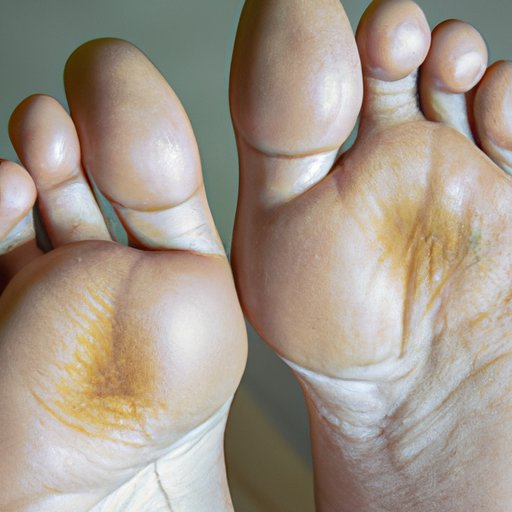
I. Introduction
Having corns on toes can be painful and frustrating. These small, hardened areas of skin develop due to repeated pressure or friction on the toes. While corns on toes may not be a serious medical condition, they can be a nuisance. This article aims to provide readers with natural remedies and preventive measures to help get rid of corns on toes.
II. Understanding Corns on Toes
Corns on toes are small, round, and thickened areas of skin that develop in response to pressure or friction. They are usually found on the tops and sides of toes and usually have a central core.
Corns develop due to the constant rubbing or pressure on the toes that is most commonly caused by improperly fitting shoes, high heels, or tight shoes. They can also form as a result of walking or running on hard surfaces.
There are two types of corns on toes: hard corns and soft corns. Hard corns are the most common and are typically found on the tops and tips of toes. Soft corns, on the other hand, are located between the toes, where the skin is moist due to sweating.
The symptoms of corns on toes include a small, raised bump on the skin, a thick and rough patch of skin, and pain or tenderness when the affected area is touched or pressed. Diagnosing corns on toes is typically easy and can be done by a healthcare provider or examination by oneself.
III. Home Remedies for Corns on Toes
While corns on toes can be painful, there are several remedies readers can try at home. Using natural remedies can help soothe the affected areas and help reduce pain and discomfort. Here are some natural remedies that readers can try:
- Over-the-counter medicated pads: There are several medicated pads that are available over-the-counter that can help with the discomfort of corns on toes. These pads contain salicylic acid, which can remove the dead skin that causes corns.
- Soak feet in Epsom salt: Soaking your feet in warm water with Epsom salt can help to soften the skin around the corns. This makes it easier to remove dead skin with a pumice stone.
- Exfoliate with pumice stone: Use a pumice stone to gently rub away dead skin from the corns. Be sure to soak your feet before exfoliating so that the skin is soft and supple.
- Apply essential oils : Mix a few drops of essential oils like lavender or peppermint with a carrier oil like coconut oil and apply this to the affected area. The anti-inflammatory properties of essential oils help relieve pain and reduce swelling.
It is essential to follow guidelines for each remedy to avoid any further damage that could lead to infection.
IV. Choosing Appropriate Footwear
One way to prevent corns on toes from developing, or recurring, is to choose the right footwear. Take into consideration the following tips for choosing well-fitting shoes:
- Shoes should be comfortable and supportive.
- Shoes should have good arch and heel support.
- Shoes with a wide toe box can relieve pressure on the toes.
- Avoid high heels, shoes with a narrow toe box, and shoes that are too tight.
Wearing appropriate shoes can help prevent corns on toes from developing, or redeveloping, depending on the circumstance.
V. Medical Treatment Options for Corns on Toes
While natural remedies and proper footwear can help prevent and treat corns on toes, sometimes professional help is necessary. Here are some medical treatment options:
- Prescription-strength medications: Your healthcare provider may prescribe medication to help get rid of the corns. These may include salicylic acid, chemical peels, or cryotherapy.
- Surgical removal: In some cases, surgical removal of corns on toes may be necessary. This is usually done under local anesthesia and may require a follow-up appointment.
- Orthotics: Sometimes, orthotics like pads or arch supports may be the best course of action for managing corns on toes. These can help distribute weight evenly, reducing pressure and friction.
If at-home remedies are not effective, or if corns on toes become too painful or infected, it is essential to contact a healthcare provider.
VI. Preventing Recurrence of Corns on Toes
Preventing corns from developing is crucial, and here are some effective ways to prevent their recurrence:
- Moisturize feet regularly to keep the skin hydrated and soft.
- Wear appropriate shoes that are comfortable, supportive and well-fitted.
- Change socks regularly to keep feet dry and clean.
- Use foot powder to absorb moisture and reduce friction between toes.
Preventing recurrence is equally vital as treating a corn. Proper prevention measures ensure a corn won’t be painful or annoying enough to necessitate medical treatment.
VII. When to See a Healthcare Provider
While corns on toes are not always serious medical problems, it is necessary to seek medical attention if any of the following occurs:
- The corn becomes infected.
- The pain becomes too intense to tolerate.
- Any discomfort develops after medical removal of the corn.
If the corn isn’t taken care of immediately, it could cause additional chronic pain, spreading to the rest of the foot or even other parts of your body. It’s best to seek medical attention if these situations occur.
VIII. Conclusion
Having corns on toes is uncomfortable and annoying, but there are some natural remedies readers can try at home that can bring relief. Properly fitting shoes and preventive measures go a long way to keeping corns from reoccurring. Most importantly, it is crucial to contact a healthcare provider if any complications or discomforts arise from treating corns on toes.
Don’t let corns on toes affect your daily life. With the remedies, preventive measures, and timely medical intervention provided in this article, readers can take charge of their comfort and health.




